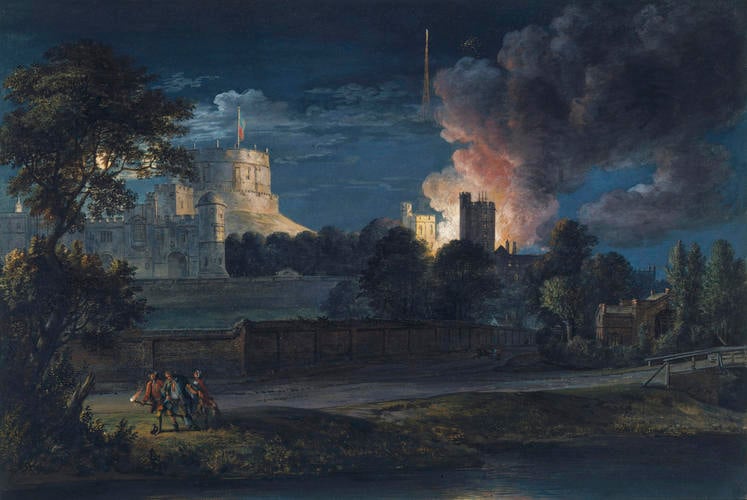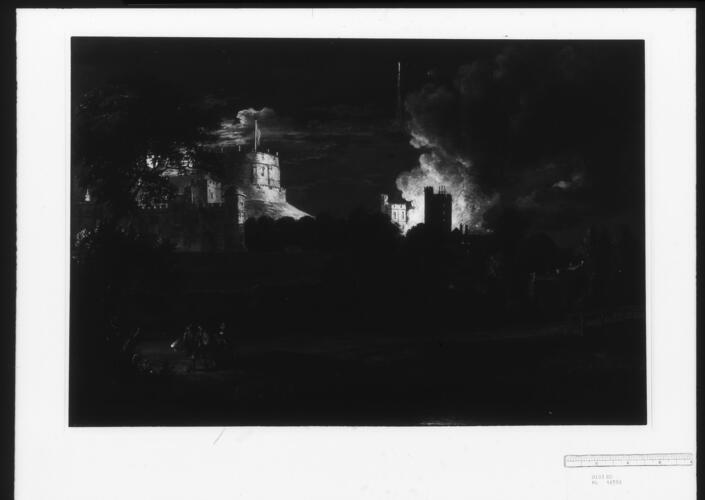-
1 of 253523 objects
Paul Sandby (1731-1809)
Windsor Castle from Datchet Lane on a rejoicing night dated 1768
Bodycolour | 30.7 x 45.9 cm (sheet of paper) | RCIN 914584
-
A bodycolour drawing of Windsor Castle with a bonfire burning in the Middle Ward; a full moon over buildings is on the left, King's Engine House to the right and the river bank at the bottom with three revellers returning. A nocturne view with fireworks and illuminations.
Paul Sandby trained with his elder brother Thomas in Nottingham, joining him as a military draughtsman to the Board of Ordnance at the Tower of London. In 1747 Paul was assigned to the Military Survey in Scotland, mapping the Highlands in the aftermath of the Jacobite Rebellion. He retained an interest in military subjects all his life, but landscapes - in watercolour, gouaches and oils - soon became his principal subject matter. Paul spent much time at Windsor after his brother’s patron, the Duke of Cumberland, was appointed Ranger of Windsor Great Park, and he produced many views of the Castle and its surroundings from the 1750s onwards.
Here a bonfire burns in the Middle Ward of the Castle, its light visible through the windows of the Winchester Tower, and a full moon hangs over the Star Buildings, where the Royal Library is now located. A drunken reveller - one stocking loose, his tricorn hat fallen at his feet, and straddling a makeshift hobby-horse - is led home along Datchet Lane by a torchbearer, a woman and two children. The King’s Engine House, designed by Sir John Vanbrugh in 1718 to pump water to the Castle, is visible to the right. Like most topographical artists, Sandby was not averse to rearranging the elements of a composition for better pictorial effect. The point on Datchet Lane from which the view is taken is about half a mile (800 m) from the north front of the Castle, which is drawn much larger than it would appear in reality, and the space between the Little Park wall and the Castle is left featureless.
Dated works by Paul Sandby are uncommon, and it may be that the work was intended to record an actual event. The year 1768 saw George III’s thirtieth birthday on 4 June and the birth of his sixth child, Princess Augusta Sophia, on 8 November; Guy Fawkes Night on 5 November was commonly marked at the time with a bonfire in the Middle Ward. That the trees are in full leaf would suggest it is the King’s birthday that is being celebrated here (the low elevation of the full moon would also suggest a midsummer date, though Sandby most probably included the moon simply to provide a diversity of light sources). On 23 June the King’s birthday was marked on Tower Hill in London with ‘fireworks ... [that] were the grandest that have been played off for many years’, though how the occasion was observed at Windsor is not recorded.
The Royal Collection now holds about 500 works by the Sandby brothers, of which over 150 are views of Windsor or projects for work in the Windsor parks. Strangely, none of these seems to have been acquired by George III. Apart from the few surviving drawings resulting from Thomas’s landscaping projects for Cumberland in the Great Park, the foundations of the collection were laid by the future George IV, who bought many works by the Sandbys through the dealers Colnaghi after the posthumous sales of the brothers’ possessions. Further acquisitions were made throughout the nineteenth and twentieth centuries, most notably at the sale of Sir Joseph Banks’s collection in 1876. The date of purchase of this gouache is unknown; it was first recorded in the Royal Collection at an exhibition organised by the Royal Amateur Art Society in 1909, when the subject was described as ‘Celebration of the 4th of June, 1768 (?)’.
Signed and dated lower left P Sandby 1768
Text adapted from Holbein to Hockney: Drawings from the Royal CollectionProvenance
Royal Collection by 1909
-
Creator(s)
-
Medium and techniques
Bodycolour
Measurements
30.7 x 45.9 cm (sheet of paper)
Category
Object type(s)
Subject(s)
Other number(s)
RL 14584

